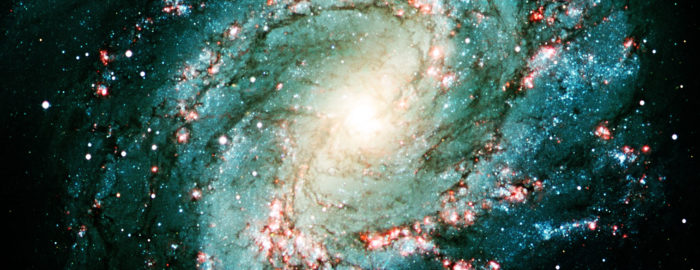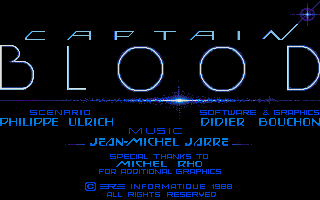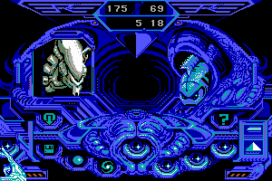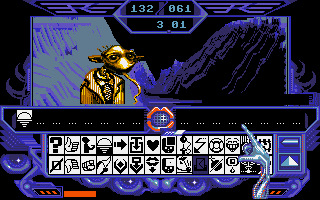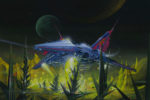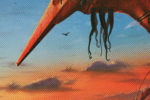Captain Blood cover
Captain Blood, or L’Arche du Captain Blood in France, his country of origin, is a video game made by Ère informatique (in some boxes, branded with their Exxos label, wich was totally dedicated to science fiction genere) and published by Infogrames in 1988. It was later re-released in the UK by Players Software Premier.
The game was first released on Atari ST and later for Commodore 64, Macintosh, Amiga, Apple IIGS, PC, ZX Spectrum, Amstrad CPC and Thomson TO8 and MO6, although the ST version is the only version that includes the entire alien language sound set. The music of the title is an abridged version of Jean-Michel Jarre’s Ethnicolor.
Captain Blood was jointly developed by Didier Bouchon and Philippe Ulrich, who dedicated themselves to the design and scenery, plus, Bouchon contributed to the graphics and programming of the Atari ST version. In fact, Bouchon originally designed covers for the Gazoline Software label for Ère informatique, but he learned to program in assembly language for the Atari ST after Ulrich supplied him with an assembler. Bouchon then created fractal-generated real-time graphics that inspired both of them to create a sci-fi themed video game.
After the purchase of Ère informatique by Infogrames in the summer of 1987 (partly interested in the preliminary versions of Captain Blood), Ulrich and Bouchon isolated themselves in the Landes Forest (Forêt des Landes) to have the game ready for Christmas. Many adaptations for both 16-bit and 8-bit machines were developed in the following months, although they were direct ports of the original Atari ST in graphics, sound effects, or music.
The plot is very particular: the protagonist, Bob Morlock, is a video game programmer who despite him finds himself trapped inside his latest creation. Here he takes the nickname Captain Blood, in tribute to the novel of the same name by Rafael Sabatini, brought to the screen by Errol Flynn, in Michael Curtiz’s 1935 film of the same name.
Following an accident during hyperspace, it is cloned 30 times and these replicas, which will suck the lifeblood of the original, are lost in space. In about 800 years the protagonist manages to find and reabsorb 25 of these clones (called Duplicates or Numbers depending on the version of the game); the game begins with the search for the last five, as each takes a part of the vital fluid of him. Blood, through his “Biological Ark”, will have to explore an imaginary universe called Hydra by visiting different planets and acquiring information from various alien forms for the success of his mission.
Communication with aliens takes place via an icon-based interface known as UPCOM. There are about 150 icons, each of which represents a different concept. As each alien race discovered speaks its own language and reacts differently, the player must learn to negotiate using these UPCOM concepts in a style suitable for each race. Other unique features of Captain Blood gameplay include changes to the player interface as the game progresses; in addition, as time passed, the character’s health deteriorated, increasing the shaking of the mouse cursor and making the game increasingly difficult to control. Disintegration of a clone temporarily alleviates this symptom.
The player starts the game from the deck of his biological ship, the Ark. The ship begins its journey in the vicinity of one of four predetermined planets, each inhabited by a single alien. To make contact with an alien, the player launches an OORXX, a biological probe, on the planet’s surface. The player must successfully navigate the probe over a fractal landscape, eventually reaching the alien at the end of a valley. The UPCOM interface then appears to allow the player to talk to the alien and find more information, especially the coordinates of other inhabited planets.
The Ark also has the ability to make hyperspace leaps to other planets, scan or destroy planets, and teleport aliens to an area known as Fridgitorium , for disintegration or transport to another planet. An alien can only be teleported to the Ark after he has given his consent.
Captain Blood has sold more than 100,000 copies worldwide, receiving both positive and negative reviews, the latter due to its interface. The game was followed by Commander Blood in 1994 and later by Big Bug Bang in 1997, a French-only version.
The game cover
The cover of the game is perfectly in line with the style of the video game: minimal, mysterious and almost elegant. The main image is the Southern Pinwheel galaxy (also called Messier 83 or NGC 5236). This beautiful image was captured by the Wide Field Imager at ESO’s La Silla Observatory, located atop the mountains of the Chilean Atacama Desert.
The galaxy is about 15 million light-years away towards the huge southern constellation of Hydra (the sea serpent). It spans over 40,000 light years, making it about 2.5 times smaller than our Milky Way . However, in some respects Messier 83 is quite similar to our own galaxy. Both the Milky Way and Messier 83 have a bar across their galactic nucleus, the dense spherical conglomerate of stars at the center of galaxies.
Complete the cover, at the top, above the background image, the writing of the title of the game in Futura font, with a B without the central bar.
Capitain-Blood-front-cover.png
File type: image/png Download size: 4.68 MB Date added or updated: 18 October 2020 Download link: https://www.studiodilena.com/wp-content/uploads/2020/10/Capitain-Blood-front-cover.pngDisclaimer
All the third parties trademarks, names, graphics and logos are the properties of their respective owners.
Should any trademark, name, graphics or logo owner does not feel protected by his rights, he is invited to contact us as soon as possible for the necessary rectifications.
